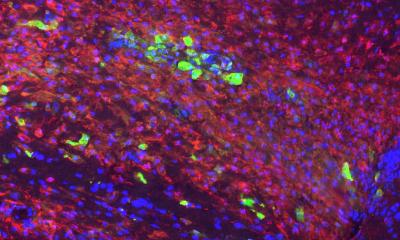News • Counteracting neuroinflammation
Multiple sclerosis: Why women get better when pregnant
Women suffering from the autoimmune disease multiple sclerosis temporarily get much better when pregnant. Researchers have now identified the beneficial changes naturally occurring in the immune system during pregnancy.

Image source: Adobe Stock/transufer
The findings, published in Journal of Neuroinflammation, can show the way to new treatments.
Pregnancy is a very special condition from an immunological point of view. The immune system serves to defend us against foreign substances. However, although half of the genetic material of the foetus comes from the father, it is not rejected by the mother’s immune system. One reason why this balancing act is almost always successful is that during pregnancy the mother’s immune system is adapted to become more tolerant.
In multiple sclerosis, MS, nerve function is hampered due to the immune system attacking the fat that serves as an insulating sheath around the nerve fibres. The nerves become inflamed, which could lead to nerve damage. Although new and more effective treatment options are available, most MS patients deteriorate over time.
Researchers believe that the temporary dampening of the immune response could explain why women with MS actually get better when pregnant. Periods of symptoms, i.e. relapses, decrease by 70% during the last third of pregnancy. Also some other autoimmune diseases, such as rheumatoid arthritis, temporarily ameliorate during pregnancy. But the reason for this has not been clear. This is why the researchers behind this study wanted to investigate what mechanisms that could be of particular importance for the decrease in symptoms during pregnancy, as a step to finding future treatment strategies that give the same effect in MS and possibly also other similar diseases.
The biggest changes happen in the last third of pregnancy, and this is where women with MS improve the most [but] it is important to stress that disease activity thereafter goes back to what it was prior to the pregnancy
Sandra Hellberg
The researchers were particularly interested in T cells, which play an important role in the immune system. Moreover, T cells play a key role in driving MS and are important during pregnancy. The study compared 11 women with MS to 7 healthy women who had blood samples taken before, during and after pregnancy.
To understand what happens in the immune cells, the researchers identified the genes used in the T cells at various points in time during pregnancy. They also studied changes regulating how genes are switched on and off, i.e. epigenetic changes. In their study, the researchers looked more specifically at one such regulation mechanism called DNA methylation. “What was possibly most striking is that we couldn’t find any real differences between the groups during pregnancy, as it seems that the immune system of a pregnant woman with MS looks roughly like that of a healthy pregnant woman, says Sandra Hellberg, assistant professor at the Department of Biomedical and Clinical Sciences at Linköping University and one of the researchers behind the study.
The researchers found networks of interacting genes that are affected during pregnancy. Their study shows that these genes are to a large extent linked to the disease and to important processes in the immune system. “We can see that the changes in the T cells mirror the amelioration in relapse frequency. The biggest changes happen in the last third of pregnancy, and this is where women with MS improve the most. These changes are then reversed after pregnancy at the point in time when there is a temporary increase in disease activity. It is important to stress that disease activity thereafter goes back to what it was prior to the pregnancy,” says Sandra Hellberg.
The network of genes affected during pregnancy also included genes regulated by pregnancy hormones, mainly progesterone. The researchers are now testing various hormones in the lab in an attempt to mimic the effects observed in the study, to see if these can be part of a possible future treatment strategy.
This research is the result of long-standing collaboration between researchers in medicine and bioinformatics. A key part of the project has been understanding the large amount of data by analysing it using what is known as network analysis, developed over many years by, among others, a research group led by Mika Gustafsson at Linköping University. Network analysis is a tool for finding genes that interact extensively with the genes the researchers are interested in. It often turns out that other genes in the network are regulated in an abnormal manner and indirectly affect key processes in a disease.
“Such insights can be used to find alternative medication and find new biomarkers to be able to differentiate between subgroups of a disease. We have used this strategy successfully for analysis in research into for instance allergy and multiple sclerosis”, says Mika Gustafsson, professor of Bioinformatics, who is now making the analysis available to other researchers through a newly founded company.
The study is a sub-study of the GraMS (Pregnancy and MS) study and was carried out in collaboration between Linköping University, the Karolinska University Hospital in Solna, Linköping University Hospital, Länssjukhuset Ryhov in Jönköping and Region Kalmar. The study was funded by the Swedish Foundation for Strategic Research, the Swedish Research Council, NEURO Sweden, the Swedish Foundation for MS Research, Region Östergötland, Linköping University and others.
Source: The Swedish Research Council
13.06.2023











